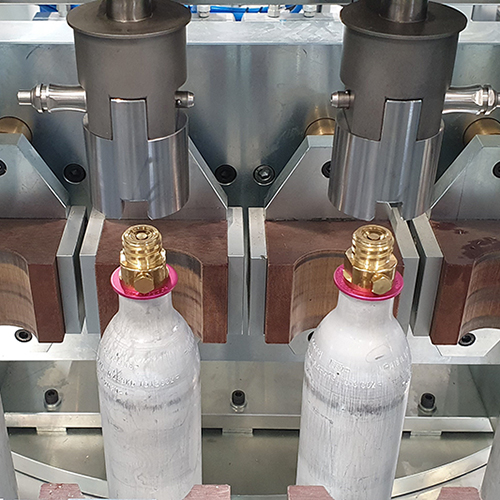
Sectors
Valves/Gas
Productivity
2000 bottles/hour
Applied technology
Vision system
Camas Technology
Rotary table | Robotic systems | 3D vision systems
This robotized island, designed and built by Camas, carries out the assembly of the opening valves on CO2 cylinders.
The productivity of this system is 2000 bottles/hour without any intervention on the part of the operator other than the subjugation of the components.
The line is composed of:
The delicacy of the valves (protection of the thread) and the volume of the cylinders and the management of the two components within the customer’s production cycle, required different types of interlocking systems. Each one dedicated to the specificity of the component.
Camas has completely designed and developed the 3D vision system that allows the recognition of bottles arranged in boxes and guides the robot to the grip.
In order to allow a continuous production of the robotized island, without stops for container changeover, two pick-up points have been created where two containers can be positioned and prevent the interchange from generating machine stops.
The great elasticity of anthropomorphic robots allows to carry out several operations in addition to the simple classic pick&place.
Before the valves are brought onto the rotary screwing table, a safety ring is fitted to the valve and a threadlocking sealant is then dispensed.
The technical specifications require the adhesive to be partially dried before the valve can be screwed onto the bottle.
For this reason an automatic storage system has been created to allow the valve to rest for 1 hour before being mounted.
The system automatically presents only those valves that have rested for the necessary time to the loading robot.
The two loading areas and the table are connected by robots. In this case, Yaskawa anthropomorphic robots were used in order to have only one brand of robot inside the production site. However, Camas is able to program the main brands of robots, carefully chosen according to the application to be performed.
On the rotary table the actual assembly takes place: the valve is screwed to 55 Nm, where 4 Siemens Brushless motors, directly managed through the Camas Supervisor.Net operator interface, finalize the screwing.
Two different bottle diameters and heights can be managed by the robotic island.
All the equipment that must necessarily be interchanged for the production changeover are made with quick release systems or with automated systems that, through special routines, are activated at the recipe changeover.